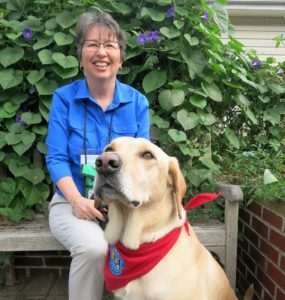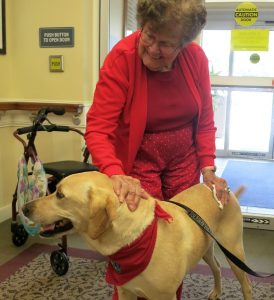October 15, 2019 —
The companionship of a beloved pet can be enjoyed at any age, and while animals may not speak using words, their compassionate presence can be healing to the mind and body. Recently, the Daily Local ran an article highlighting the benefits of therapy animals in assisted living. Kathy Cross, a therapy dog volunteer at Barclay Friends Continuing Care Community in West Chester, shares her experience below.
“Chilidog was a rescue dog from a kill shelter,” Kathy says. “A Yellow Lab Hound Mix—he was four months old when we got him and he’s seven now. Until he was two years old he was crazy. He wouldn’t come when you called his name—he was just a crazy, goofy dog, just like a Lab should be. Once he hit two years,” Kathy adds, “he calmed down.”
Kathy’s first inklings of Chili’s promise as a therapy animal surfaced on daily walks around her neighborhood. “Everybody wanted to pet him—we couldn’t go anywhere! I saw the interaction between people and him, and I thought, ‘He would be a good therapy dog.’”
Therapy Dogs International® (TDI) shares a list of testing requirements on its website, which is where Kathy went to learn what would be expected of Chilidog. “I worked with him at home to learn the usual commands—‘Sit,’ ‘Stay,’ ‘Leave it’—but there are things you can’t prepare a dog for, like wheelchairs and walkers; I don’t have those at home,” she laughs. “All of these things were to prepare him to come into a nursing home and ensure his safety and manageability.”

Chilidog passed with flying colors. “TDI gave me a list of communities near my zip code and I chose Barclay Friends—it’s close to home, and you don’t want to transport an animal a long way.” Kathy and Chilidog have been visiting residents at Barclay Friends for almost two and half years.
“I was nervous at first,” Kathy recalls. “I didn’t know any of the residents or the different neighborhoods. It was the first community we’d ever visited at and I was unsure how he would react to people, but I saw absolute happiness. People that cannot communicate had smiles on their faces, and I knew he was doing some good.”
“I’m retired—I have the time to do this. I’ve volunteered all my life, and at the time, I thought, ‘This is the next phase.’ My husband always tells me that it’s a good thing we’re doing, and as long as we can come, we will.”
“There are residents who wait for me every Tuesday,” Kathy says. Indeed, many residents ask for Chilidog by name. A resident named Frank always says, ‘Come to grandpa.’ Another resident named Sonia has her head down most of the time—I gently tap her on the shoulder and point down at Chilidog. My goal is to make her smile, and 99% of the time it works. Many of these people had pets all their lives, and as I get to know them, [I recognize] that it’s rewarding for them—and for us.”